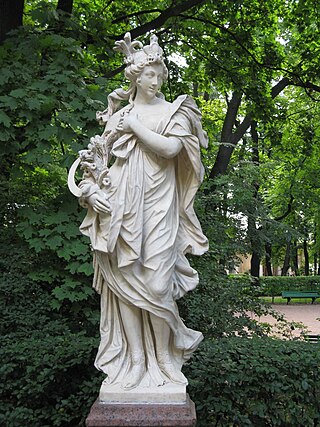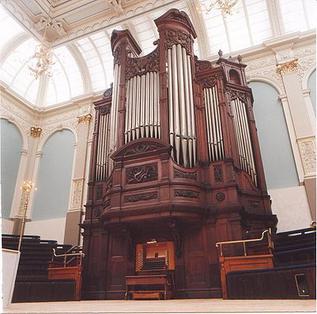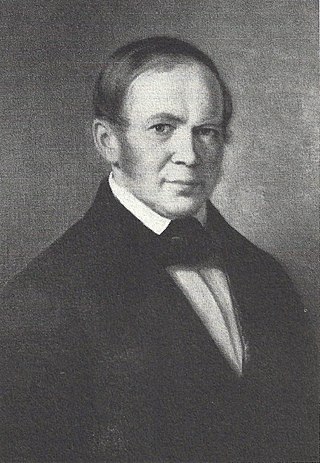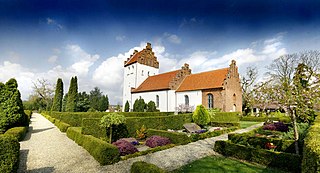



Theodor Frobenius was born into a family of organ builders on 7 October 1885 in Weikersheim, Bavaria. From the age of 13, he trained as an organ builder at August Laukhuff in his home town. He spent four years in the workshop and then another three and a half years as a journeyman with other German organ builders. He met the Danish organ builder A.C. Zachariassen. In 1907, he moved to Aarhus where Zachariassen had just taken over an organ workshop. Frobenius's original plan was to spend only a year or two in Denmark, but ended up settling in the country on a permanent basis after meeting his future wife while working on the renovation of the organ in Viborg Cathedral.
Frobenius Orgelbyggeri (Th. Frobenius & Sons / Th. Frobenius & Sønner Orgelbyggeri A/S) was founded in Copenhagen by Theodor Frobenius (1885–1972) in 1909. The firm moved to Lyngby in 1925. Theodor's sons Walther and Erik joined the company in 1944, at the same time that they began to build organs in the classical tradition, with mechanical actions and slider windchests. They build organs with characteristic modern casework, usually arranging the pipework of each manual such that three to six repeating arrangements of front pipes are shown in the façade. Their organ development after 1925 was in the style of the Organ Reform Movement and neo-classical design. [1]

Aristide Cavaillé-Coll was a French organ builder. He has the reputation of being the most distinguished organ builder of the 19th century. He pioneered innovations in the art and science of organ building that permeated the profession and influenced the course of organ building, composing and improvising through the early 20th century. As the author of scientific journal articles about the organ construction details, he published the results of his research and experiments. He was the inventor of the symphonic organ being able to follow smooth and immediate dynamic changes like a symphonic orchestra. This goal was reached by: a) invention of harmonic flue and reed stops, such as the ''flûte harmonique'', ''trompette harmonique'', ''clairon harmonique'', b) invention of divided windchest with 2-3 different wind pressure sections, c) creation of groups of stops allowing for fast dynamics changes without taking hands out of the keyboards by the organist, d) organ specification planning on the base of ''orchestral quartet". His most famous organs were built in Paris in Saint-Denis Basilica (1841), Église de la Madeleine, Sainte-Clotilde Basilica (1859), Saint-Sulpice church, Notre-Dame Cathedral, baron Albert de L'Espée's residence in Biarritz, and many others. After Cavaillé-Coll's death, Charles Mutin maintained the business into the beginning of the 20th century. The organ reform movement in the 20th century sought to return organ building to a more Baroque style; but since then, Cavaillé-Coll's designs have come back into fashion.

Frederik Reesen Magle is a Danish composer, concert organist, and pianist. He writes contemporary classical music as well as fusion of classical music and other genres. His compositions include orchestral works, cantatas, chamber music, and solo works, including several compositions commissioned by the Danish Royal Family. Magle has gained a reputation as an organ virtuoso, and as a composer and performing artist who does not refrain from venturing into more experimental projects – often with improvisation – bordering jazz, electronica, and other non-classical genres.

Aarhus Cathedral is a cathedral in Aarhus, Denmark. It is the longest and tallest church in the country, at 93 m (305 ft) in length and 96 m (315 ft) in height.

Thomas Quellinus, also known, especially in Denmark, as Thomas Qvellinus, was a Flemish baroque sculptor. He was born in Antwerp as a member of the well-known Quellinus family of artists active in 17th century Antwerp. He worked most of his career in Copenhagen, Denmark, where he operated a workshop. He is especially known for the production of grandiose and sumptuous memorial chapels, sepulchral monuments and epitaphs, which can be found in churches throughout Denmark and northern Germany's Schleswig-Holstein area. His chapels and monuments are dramatically composed, executed in rare, differently coloured types of marble and framed by monumental architectural components.

Henry Willis & Sons is a British firm of pipe organ builders founded in 1845. Although most of their installations have been in the UK, examples can be found in other countries.
William Drake (1943–2014) was the founder of the firm of William Drake, Organ Builder that manufactures pipe organs in Buckfastleigh, Devon, England. He held a Royal Warrant as organ builder to Queen Elizabeth II.
Marcussen & Søn, also known as Marcussen and previously as Marcussen & Reuter, is a Danish firm of pipe organ builders. They were one of the first firms to go back to classical organ-building techniques, and have been producing mechanical-action organs since 1930. Aside from their many instruments in Denmark, they have built organs in northern Germany, Sweden, Finland, the Netherlands, Great Britain, South Africa, Japan, and the United States.

Walcker Orgelbau of Ludwigsburg, Baden-Württemberg, Germany, is a builder of pipe organs. It was founded in Cannstatt, a suburb of Stuttgart in 1780 by Johann Eberhard Walcker. His son Eberhard Friedrich Walcker moved the business to Ludwigsburg in 1820.

J. W. Walker & Sons Ltd is a British firm of organ builders established in 1828 by Joseph William Walker in London. Walker organs were popular additions to churches during the Gothic Revival era of church building and restoration in Victorian Britain, and instruments built by Walker are found in many churches around the UK and in other countries. The firm continues to build organs today.

The Hope is a work for brass band, percussion, choir, and organ written in 2001 by Frederik Magle, depicting the Battle of Copenhagen in 1801. It consists of two movements with the first being purely instrumental. The choir enters in the second movement using text from Psalm 27.

The Church of Our Lady is a historical building at Kalundborg in northwestern Zealand, Denmark. The precise date of construction is not known with any certainty, though its architecture indicates the early part of the 13th century. With its five distinctive towers, it stands on a hill above the harbour, making it the town's most imposing landmark.

Jørlunde Church is a late Viking age/early medieval church situated in Jørlunde, Denmark. The church was built by Skjalm Hvide around the year 1085.

St. John's Church is a church located next to Sankt Hans Torv in the heart of the Nørrebro district of Copenhagen, Denmark. Opened in 1861, it was the first church to be built outside the city's old fortification ring when it was decommissioned and new residential neighbourhoods sprung up outside the former city gates.

St. Paul's Church is a Lutheran church in central Copenhagen, Denmark, also colloquially known as Nyboder's Church due to its location in the middle of the Nyboder area. It was designed by Johannes Emil Gnudtzmann and constructed from 1872 to 1877.

Like a Flame is a double-album with free improvisations for organ by Frederik Magle released in December 2010 on the Swedish record label Proprius Music. It was recorded on the then new Frobenius pipe organ in Jørlunde church on December 22–23, 2009. Frederik Magle recorded a total of 60 free improvisations over the course of the two days and later selected 23 to be released on the double album. The improvisations was recorded in one take.

Bragernes Church is a parish church at Drammen in Viken county, Norway.

Vilhelm Theodor Walther was a Danish architect and Royal Building Inspector for Jutland. He was born in Kongens Lyngby, Denmark and died in Aarhus. He was twice awarded the Academy's Neuhausen Prize for excellence in architecture and in 1885, he received the Cross of Honor of the Order of the Dannebrog. Walther completed a considerable amount of restoration work on the cathedral and St Paul's Church in Aarhus and designed a number of churches in the area. Walther died in Aarhus in 1892 of cholera.

Lundtofte Church is a Church of Denmark parish church in Lyngby-Taarbæk Municipality in the northern suburbs of Copenhagen, Denmark. It was completed in 1921 but is built in the style of a typical Danish white-washed village church.

Taarbæk Church, formerly known as Skovkapellet, is a Church of Denmark parish church in Taarbæk, Lyngby-Taarbæk Municipality, some 15 km north of central Copenhagen, Denmark. The church and adjacent cemetery is bordered by Jægersborg Dyrehave to the north and west and by the Coast Line to the east. The church was inaugurated in 1864 but Taarbæk Paris was not disjoined from that of Lyngby until 1907.
The Fairest of Roses is a fanfare for two trumpets and organ written in 2017 by Frederik Magle and published by Edition Wilhelm Hansen.